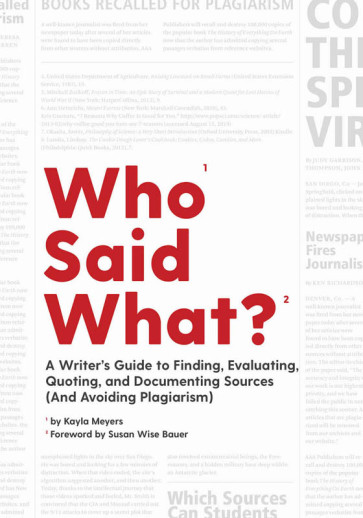We use cookies to make your experience better. To comply with the new e-Privacy directive, we need to ask for your consent to set the cookies. Learn more.
Who Said What? A Writer's Guide to Finding, Evaluating, Quoting, and Documenting Sources (And Avoiding Plagiarism)
Subtitled, A Writer's Guide to Finding, Evaluating, Quoting, and Documenting Sources (and Avoiding Plagiarism), this straight-forward, distilled, and practical resource deftly assists you in the 2 challenges of research papers: the practical and the analytical. The practical: finding sources, taking notes correctly, documenting (discusses styles, gives examples, includes a quick reference), organizing all this information and writing your analysis. The analytical: evaluating information, determining good sources, avoiding the levels of plagiarism, discerning types of knowledge, and more. Written by a Well-trained Mind Academy teacher, this user-friendly resource is a must-have for anyone tackling the necessary tasks of researching and accurate writing. ~ Ruth 7"x 10", 86 pgs, pb. ~ Ruth
Who Said What?: A Writer's Guide to Finding, Evaluating, Quoting, and Documenting Sources (and Avoiding Plagiarism) is a thorough, accessible guide to research, citation, and source evaluation, designed to assist students growing up in an era of changing media, fake news, alternative facts, and information overload.
Is Yahoo Answers a good source for your History essay? How about InfoWars? How do you include another person's ideas in your work without stealing them? Should you cite an Instagram post as a source, and if so, how do you do it? Who Said What? provides students from middle school through college with a reliable, friendly guide through the often bewildering process of research, note-taking, and documentation.
Drawing on years of teaching, research, and writing experience, Kayla Meyers teaches you how to evaluate the trustworthiness of a source, how to use it without stealing it, how to properly credit its creator, and why all of this even matters. With contemporary examples and step-by-step explanations that made Susan Wise Bauer's Writing With Skill series so popular, Who Said What? will become an essential resource for 21st-century writers.
These materials cover various types of informational writing, includingpersuasive writing, essays, outlines, and research papers.
| Product Format: | Paperback |
|---|---|
| Brand: | Well-Trained Mind Press |
| Author: | Kayla Meyers |
| Grades: | 6-AD |
| ISBN: | 9781945841422 |
| Length in Inches: | 10 |
| Width in Inches: | 7 |
| Height in Inches: | 0.25 |
| Weight in Pounds: | 0.5 |

